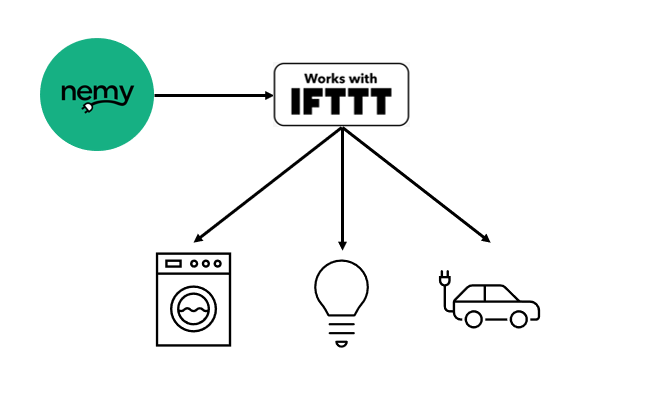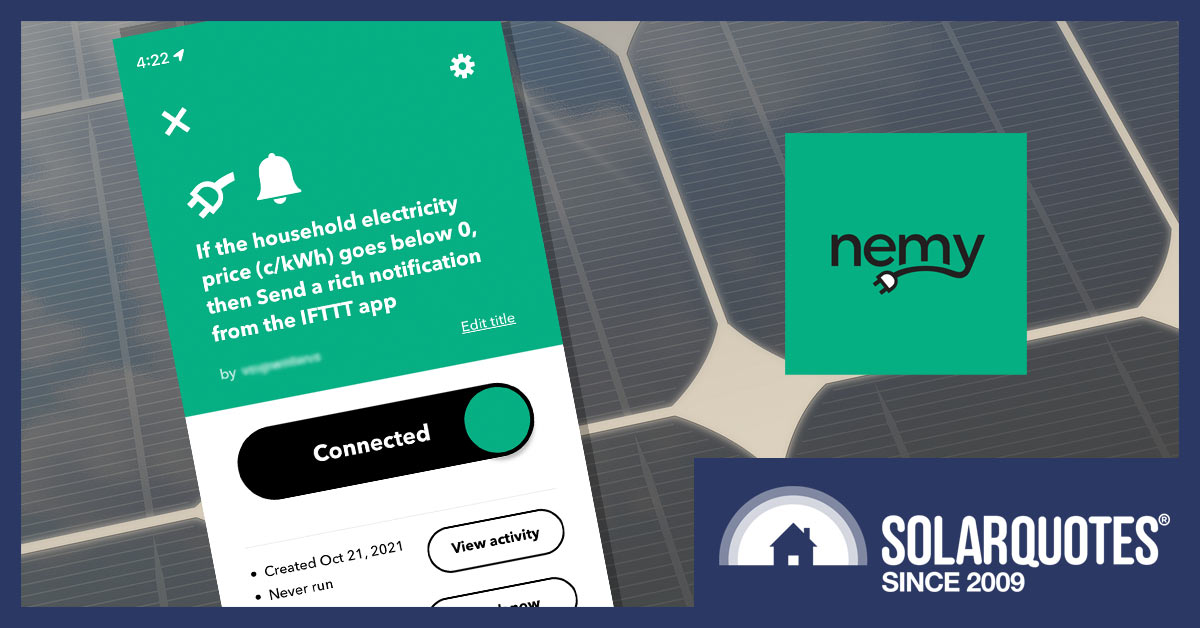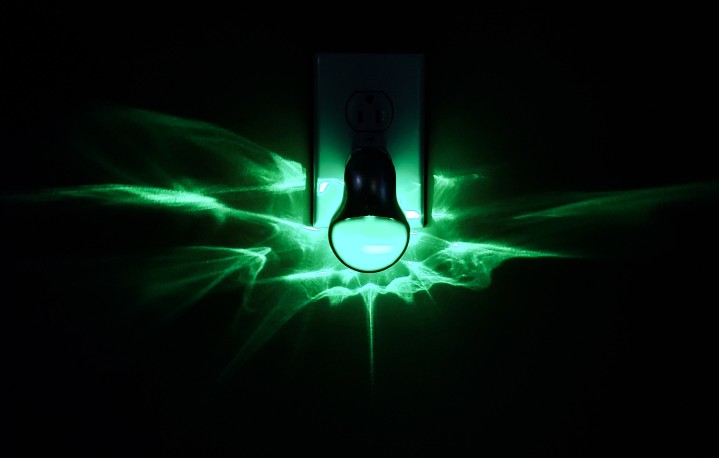Take a couple of electrical engineers sharing a home, add lockdown boredom, and what you might get is a nifty way of using electricity market information to help customers consume electricity when it’s green. And where their electricity retailer passes on real time wholesale electricity prices, cheap.
Meet nemy, the brainchild of Samuel Poustie and Jarman Stephens. Their offering starts very simple: the most basic being an If This Then That (IFTTT) integration in conjunction with the free IFTTT phone app that will tell you when renewable sources dominate the grid, according to AEMO’s five-minute updates.
When lockdown started in Melbourne last year, they’d just switched the energy provider in their shared rental to Amber Electric. With a provider that provides the wholesale price, they decided,
“let’s try and get some visibility into that price.”
It started with getting a smart light globe to go green when it was a good time to use power, and red when there was a price spike, Poustie explained. A price spike is also often indicative of more fossil-fuel generation entering the mix.
From there, the next step was to look at AEMO data, which publishes price and dispatch on all generators on a five minute cycle.
“We go and scrape that information, it’s very convoluted and not very user-friendly, and turn that into useful things for people. For Amber customers, price, but for a lot of other customers, the very important thing is the amount of renewables in the grid.
So we look at the fuel source – coal will get a cross, solar will get a tick, wind will get a tick – and no matter what retailer they’re with, they can still get that indication of what the carbon impact is of using electricity at every five minute block”, Stephens explained.
For the more adventurous customer, the IFTTT integration lets more advanced users take nemy’s information and utillise it as a control system for their smart appliances.
Stephens gives his own fairly straightforward use of nemy: a cheap smart plug operates the dishwasher when the grid is green, and another controls the washing machine.

Simplicity itself: nemy can act as an input to the IFTTT platform, powering your appliances when the grid is at its greenest
“Quite recently, there was a price spike in the five-minute update, so the dishwasher turned off for five minutes, waited, and turned back on. It feels quite futuristic,” he said.
The Proposition For Solar Installers
Other customers are using nemy plus ITTT for more advanced load-shifting – pouring electrons into their EV batteries when the grid’s green, for example.
Stephens pointed out the other aspect of nemy’s approach is their decision to use existing systems like Amazon Alexa and Google Home,
“rather than developing our own ecosystem, where you need a box, pay $1,000, and you need an electrician to put it in the switchboard.”
There’s also a pretty straightforward proposition installers could take advantage of here: doing the setup for solar customers like “my clueless friend Chris”, who would like to have load shifting and/or time shifting taken care of, but don’t have the early adopters’ enthusiasm for tinkering with their systems.
“We’ve thought about teaming up with installers, because the type of customer installing solar would be interested in the type of electricity they’re using”, Stephens said; adding that it would be “exciting” to team up with installers.
“But we’re also trying to go mass market here, to push into the millions of Australians. You can get started with just your phone, and it’s free. So you just get notified when it’s really cheap and green, so people can then, without any devices and any setup, get notified that now is a great time to wash their underpants and hang them on the line”, Stephens said.
And while other electricity retailers may not provide the detailed information Amber Electric does, no matter what retailer a customer is with, nemy can tell them the carbon impact of using electricity in each five minute block through the day.



 RSS - Posts
RSS - Posts



Very interesting concept!
I love solar, wind and other renewables (geothermal, tidal, hydro, heavy weights etc) and the idea of access to fast data, but am a bit confused by the statement that “a price spike is often associated with more fossil fuel generation entering the mix’. One of the problems with coal-fired, in terms of dynamics, is that they can’t switch on and off quickly but take many hours to bring online and offline, so more information about how there could be a price spike would be useful. Surely a price spike would be demand-side rather than supply side? And if extra supply is coming in, then being a market environment, the wholesale price would drop, not spike?
Does AEMO provide comparative tables on the price per GWHr based on generation type?
When there is a demand spike, it is the higher priced generation sources that come online. This is usually gas fired peaking plants, and if we get really desperate, big diesel generators. These are the most expensive forms of generation.
The way the National Electricity Market bidding works is that peaking generators switching on makes everything more expensive – they use the cheapest generation first and most expensive last.
https://www.aemc.gov.au/sites/default/files/content//Five-Minute-Settlement-directions-paper-fact-sheet-FINAL.PDF
Turning a dishwasher or washing machine off and on mid cycle seems counterproductive to me, especially if it’s in the middle of or has just recently finished a water heating cycle. The effectiveness of cleaning is water temperature dependent.
It will either have to reheat the water (thereby wasting energy) or worse, continue a cycle using water of inadequate temperature to clean dishes to a safe sanitation level.
But honestly, just using appliances when the sun is high in the sky will achieve pretty much the same thing as that’s when grid emissions are lowest.
We need smarter appliances that we (the power management system) can have a chat with – “are you able to delay for a while?”, “do you need this power right now?” etc.. A washing machine would be just fine not spinning clothes out right now. Similarly hot water/airconditioning/fridge etc..
If you power off a washing machine or dishwasher, does it return back to the same state (“currently washing”) or does it go back to “nothing happening” mode?
As well as some predictive models (“the sun is out right now so lots of solar – do we expect clouds soon, or have clouds been spotted and are headed for panels”) either at the local level for your own solar production, or from utility level systems.
I’m not sure there’s much to be gained by halting appliances like dishwashers and washing machines mid-cycle, the downside risks are not worth the few cents or milligrams of CO2 one might save.
Except for periods of water heating they are not particular high power draw appliances. Run them in the middle of the day and that’ll cover most scenarios for using cheap renewable energy. More than that is overkill.
Our dishwasher returns to prior operating state I think. Not sure about washing machine, I think it too will continue the set program where it left off. Both already have built in start delay timers which we use as does the heat pump clothes dryer if hanging clothes out is not feasible.
Some appliances should not return to their prior state once power returns, e.g. ovens and cooktops, as it’s a safety issue. Slow cookers can present a food safety issue if power is interrupted.
Hot water storage is a load much more to suitable for supplying variable / intermittent power.
The other is space heating/cooling where control over thermostat settings can help to knock off some energy consumption at key times, or pre-cooling/heating the house if it has reasonable thermal properties. But a hard shut down is not something you want to force on a compressor based system with any regularity.
Another are pool pumps and if used, pool heaters. These should already be programmed to operate during best hours.
As to visualising when power is “greener”, you can view that here:
https://co2signal.com
which provides real time data on the emission intensity of the grid power in your region.
I have it integrated into my Home Assistant energy page and it tells me the emissions intensity of our electricity consumption. e.g. yesterday we were 63.6% from non-fossil sources (NSW).
Thanks Alex,
That link you gave for co2signal.com provides some useful information.
The Nemy device might apply to some, but for the ‘average’ householder with roof-top solar PV who is already ‘time-shifting’ his consumption toward the middle of the day, the added benefits seem pretty marginal to me.
Still, non-PV owners could find it helpful as a way of reducing their household carbon footprint to some degree perhaps
I think a more basic problem is many people with Time of Use tarrifs don’t know much about them, eg. when they kick in and what is their relative cost.
How about a simple traffic light system based on consumption cost as that might help shift or reduce demand?
I have had Solar Panels for nearly a year and know very well about weekdays vs weekends, 6.50 am vs 7am to boil the jug for the morning cuppa in winter or a cloudy day, and lastly 2 to 8pm on weekdays. And thanks to a very large gum tree in the west, my major energy production stops around 4pm, smack bang in the middle of my peak cost period.